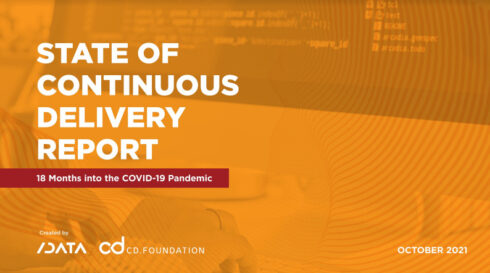
Over the past year, software development has seen an increase in the adoption of Lean software delivery practices. According to the “2021 State of Continuous Delivery Report” conducted by the Continuous Delivery Foundation, 74% of developers are currently utilizing some kind of DevOps practice. However, the software development community as a whole remains in the early phases of adopting DevOps and fully automating the delivery process.
Tracy Miranda, executive director of the Continuous Delivery Foundation said, “Our State of CD report focuses on developers, and the data certainly shows that DevOps is widespread in organizations of all sizes. However, despite a common perception that industry is accelerating software delivery adoption, for teams, the data shows no signs that velocity is increasing. Better onboarding materials, less complex systems and more will be needed to improve software delivery in 2022.”
The report found that while 44% of developers use either continuous integration or deployment (CD/CD), less than 18% employ both practices to fully automate their delivery processes. The report also found that continuous integration is currently the most widely used DevOps-related activity with 32% of developers surveyed reporting that their organizations use CI in practice. Furthermore, only 29% of respondents said that they are currently using continuous deployment as their main method of delivery automation.
Additionally, it was found that DevOps is becoming mainstream not only for developers of internet-centric applications or complex distributed systems, but throughout all sectors of the software economy. This goes for organizations of vastly varying sizes. 80% of developers who are employed by companies with two or more workers reported that they are involved in DevOps practices. The report showed that the key difference between companies of differing sizes is the degree to which they have adopted these DevOps practices.
The report found that nearly 60% of enterprise developers use CI/CD in their workflow. Comparatively, only 48% of developers working in small companies and 42% of freelancers said that CI/CD played a part in their development processes.
There is still a way to go until the majority of organizations obtain a fully automated software delivery process. The study showed that as of Q3 2021, only 14% of developers surveyed took, on average, less than one day to go from code checked-in to having that code running successfully in production. In this same vein, only one in 10 developers reported that they deploy code into production multiple times per day, and the proportion of top performers in terms of lead time for code changes dropped from 17% in Q3 2020 to 14% in Q3 2021.
This slowing of software delivery may be the result of the increased complexity and intricacy of modern-day software projects. In large-scale enterprises the report found that only 14% of developers showed lead times for changes of less than a day in Q3 2021. This is a decrease from last year where the study showed 18% performing at this level. This downward trend is steady among any size organization, with medium sized companies down from 16% to 14% and small organizations from 19% to 17%.
Over the past year, the amount of developers who are able to quickly restore an unpredicted, user-impacting incident also shows a deceleration. The proportion of those who need less than one hour to restore service dropped from 17% to 13%. However, for this metric, medium sized businesses showed the greatest drop in performance when compared to larger and smaller organizations.
The study also revealed that the two strongest predictors of a high-quality software delivery performance are the areas that developers are involved in as well as their experience level. Developers with more than 16 years of experience behind them are almost twice as likely than beginners to be top performers in terms of lead time for code changes. With this, the likelihood of performing poorly showed a drop from 54% among those who are just starting out to 10% among seasoned developers.
As mentioned earlier, it is not just developers working on internet-centric applications that are taking advantage of DevOps practices, however, they are the ones with the highest concentration of top performers. Specifically, extensions of third-party ecosystems, back-end services, and web applications possess the highest number of top-performing developers for software delivery speed.
To read the full report, visit here.






